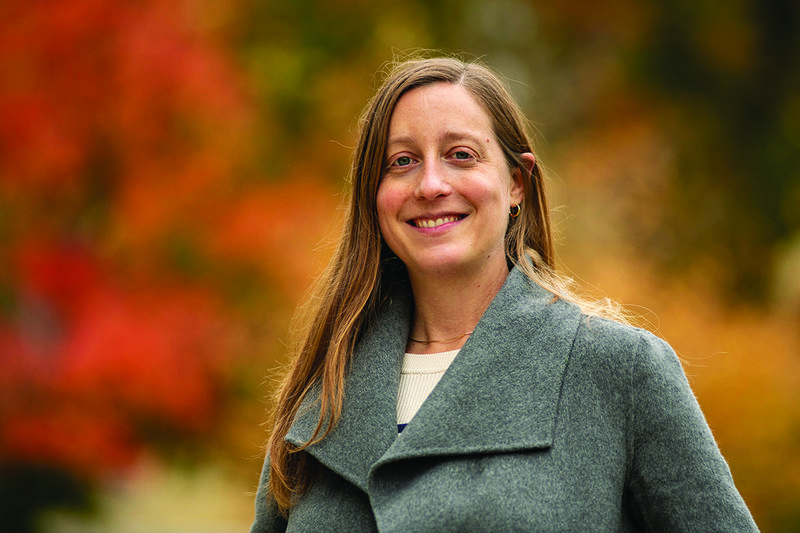 Photo by Barbara Johnston
Photo by Barbara Johnston
Laurel Daen has been studying and writing about the history of American health, medicine and disability for years, but nothing quite prepared her for the curveball 2020 delivered.
She never expected to begin her first tenure-track faculty job by teaching remotely in the middle of the worst pandemic in a century. “It was really tough, to be honest,” says Daen, who started in July as an assistant professor of American studies and an affiliate of the University’s John J. Reilly Center for Science, Technology, and Values. Notre Dame has eased the transition by being very accommodating and supportive of new faculty members, she says.
Because of the campus coronavirus shutdown, Daen wasn’t able to move immediately into her new office upon arrival. And on this particular autumn day, she’s a couple weeks away from giving birth to her first child. “It’s been tricky,” she says. “I feel like I haven’t gotten to know people as well as I would love to, but it’s hard to do social engagements.”
Daen’s husband, Colin Jones, teaches in the Mendoza College of Business. He joined the faculty in 2019 as an associate teaching professor of finance and faculty director for the University’s Institute for Global Investing.
The coronavirus has posed great challenges in her first year, Daen says, but it also provided a singular opportunity. In the fall, she taught a course on the history of epidemics. Students were attracted by the relevance of the topic, and the enrollment filled up quickly.
COVID-19 has similarities to many other pandemics. Daen’s students learned about bubonic plague, smallpox in early America, yellow fever outbreaks in Philadelphia and New Orleans, cholera and the Spanish influenza of 1918, among others. “There are certainly differences,” she notes, “but the similarities are also striking.”
Such widespread outbreaks tend to follow patterns in how they progress and how people respond to them, Daen continues. Their stages include leaders’ initial tendency to deny their existence. “And people who are marginalized in society tend to suffer worse. That is a constant.”
During the influenza pandemic in 1918, some communities required residents to wear masks in public. Disagreements about masks in that era were every bit as volatile as Americans have experienced during COVID-19, she says.
Daen found her students engrossed in the course’s historical perspective and its relevance to the pandemic they are living through. They maintained positive attitudes throughout the term, despite their anxiety about the virus and campus regulations to slow its spread. “I think it is tough. The students want to be normal college students and they can’t be. There are so many restrictions,” she says.
Some students tuned into the class while they were in isolation or quarantine after testing positive for COVID-19 or being in contact with others who tested positive. She says the day-by-day tracking of the virus can take an emotional toll on faculty and students.
The students were required to keep journals about the COVID-19 pandemic and their personal experiences during it. She expects some may be donated to libraries and archives to provide material for future historians.
The professor wasn’t able to meet her students in person, but adapted to teaching via Zoom more easily than she had expected. “It’s been great, to be honest. Certainly it would be better to be in person and without masks,” she says. Class discussions were excellent, with the students engaged and speaking freely.
Daen’s academic specialty is disability, illness, medicine and health in America. She is writing her first book, which examines the exclusion of disabled people from legal and political rights in early America.
She notes national news stories about how COVID-19, the shutdown of many K-12 schools and work-from-home orders seem to have a greater impact on women than men, including among college professors.
“I think that’s really true,” Daen says. “That’s what a lot of my friends and other colleagues have found. It’s hard to get things done when you’re working from home and child care is not accessible or open. There are really significant challenges.”
COVID-19 threatens research productivity as well. The pandemic has limited professors’ ability to travel, and many research facilities are temporarily closed. Notre Dame leaders have been proactive in reaching out to faculty members, asking them how COVID-19 is affecting their work, Daen says.
She’s already is looking forward to the fall semester when, she hopes, campus life will be back to normal, with all in-person classes and chances to get to know her students and colleagues better.
One lesson the historian emphasized about COVID-19: It’s not going to last forever. “There’s all this ‘unprecedented’ language about the pandemic today,” she says. But pandemics arrive, they dominate for a while, then they subside. “There is a precedent here,” she says. “And I think students actually find comfort and hope in that. So I’m trying to follow that, too.”
Margaret Fosmoe is an associate editor of this magazine.